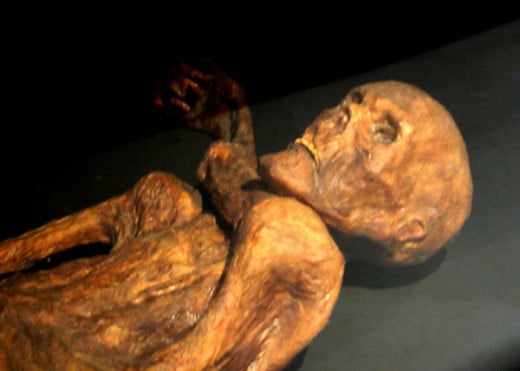Ancient Ice Man's Last Meal

In 1991, an astounding discovery was unearthed in the form of a natural mummy. This ancient man was found preserved in a glacier for over 5000 years in the Ötztal Alps near the border of Italy and Austria. Named Ötzi, he has been the topic of many archaeological studies ever since scientists realized that he is one of the oldest humans that have been found1. Ötzi continues to play a key role in allowing scientists to learn more about the Copper Age in Europe. One important topic of study has been Ötzi’s diet, which has the potential to tell us about both his culture and himself as an individual. Several scientists have used different methods of determining what made up Ötzi’s last meal, and while some techniques are more logical than others, the best tactic is to take all factors into account with a holistic view. It is especially important to take previously found information into account when using a new method, as it can serve as a comparison for the new information. This can be vital for showing the validity of the new technique and for giving credibility to the data. While some scientists used typical, holistic approaches in order to resolve the mystery of the mummy’s diet, one group of scientists neglected to consider other available data and ended up with a narrow-minded and incorrect conclusion.
The first and most obvious approach to determining what Ötzi ate would be to look at what he was carrying with him when he died. Traces of cereal grains, such as einkorn and barley, were found on his clothing2. A “grass-like plant”, a sloe fruit, and an ibex goat were also found preserved nearby him2. It would be reasonable to use these as a starting point to guess at what Ötzi ate before his death, however with more advanced scientific techniques available, it would be foolish to stop there.
The next most logical approach would be looking inside of his body where partially digested food may be preserved, such as in his stomach, small intestine, and colon. This is the method that Dickson et al.2 used when trying to determine Ötzi’s last meal. They examined samples of his colon contents under a microscope and, with the knowledge of other cultures and the geographic flora and fauna, were able to analyze what he had ingested. Although the samples contained pollen, a moss leaf, and whipworms, it is reasonable to assume that he did not intentionally ingest these matierals2. However, the samples also contained material that Ötzi likely meant to eat, such as einkorn, barley, and muscle fibers2. These findings indicate an omnivorous diet, at least right before his death.
Further analysis of the colon contents is possible, namely in the form of DNA analysis. In order to carry out this method, scientists first collect samples from the gastrointestinal tract. Next, they extract the DNA, followed by using PCR amplification and sequencing in order to make more copies that can then be compared to known DNA sequences. Rollo et al.3 used this technique to determine both Ötzi’s last meal and his second to last meal, based on where the samples were located along his digestive tract. His second to last meal consisted of cereals, other plants, and ibex meat, which is the breed of goat that was found near his body3. His last meal was made up of red deer meat and likely more cereals3. Such conclusions further support the notion that Ötzi was an omnivore.
While this line of reasoning seems to be the most logical when trying to determine the ancient man’s last meal, some scientists decided to try new methods. Macko et al.4 used a revolutionary technique of doing isotopic analysis on hair samples, which are often well preserved. By analyzing Ötzi’s hair for both carbon 13 isotope and nitrogen 15 isotopic ratios, and then comparing those figures to the goat found near him, the grass found near him, and modern people with different diets, Macko et al.4 concluded that Ötzi would have been a vegetarian. Unfortunately, there were flaws in their analysis, leading them to an unlikely conclusion that is easily refuted.
The first major problem with Macko et al.’s4 reasoning is that nitrogen levels are variable, especially in plants2. Only one plant was sampled and compared against Ötzi’s isotopic ratios, which would be insufficient to give a range of reasonable nitrogen 15 isotope ratios within plants at that time2. In addition, he mostly ignores the nitrogen ratios within the ibex. Nitrogen 15 ratios are known to be more reliable in mammals than in plants anyway, and since the levels are higher in the ice man relative to the ibex, it would be reasonable to deduce that he was not a full herbivore, but actually an omnivore2. Another problem is that Macko et al.4 compare Ötzi’s hair sample to modern hair samples of two vegans, eight vegetarians, and one omnivore. The uneven sample sizes, the possible inconsistencies in diet among the modern samples, and the differences between modern diets and ancient diets all present sources of error which they do not fully take into account. Rather, they assume that the data is sufficient and conclude that Ötzi was a vegetarian4.
Trying new methods is typically encouraged in scientific communities, but not if it entails completely ignoring tried and true methods that indicate very strongly otherwise. Using different techniques is usually helpful because it either solidifies existing data or challenges old testing methods. However, in this case, Macko et al.4 blatantly disregarded previous studies that had investigated contents of the colon, which they should have researched before publishing their paper2. While the idea of analyzing hair to reach diet-based conclusions was a new and significant one, the study itself was poorly conducted and relied on too many assumptions. Rather than looking at all of the material that was already available, Macko et al.4 refused to stop and question when their data did not match multiple other studies. They would have been better off examining all information on the topic and incorporating other findings into their conclusions rather than continuing with their narrow-minded approach.
References
- Roberts, D. The Ice Man. National Geographic, 36-67 (1993).
- Dickson, J. H. et al. The Omnivorous Tyrolean Iceman: Colon Contents (Meat, Cereals, Pollen, Moss, and Whipworm) and Stable Isotope Analysis. Philosophical Transactions: Biological Sciences, 355, 1843-1849 (2000).
- Rollo, F., Ubaldi, M., Ermini, L., & Marota, I. Otzi’s last meals: DNA analysis of the intestinal content of the Neolithic glacier mummy from the Alps. Proceedings of the National Academy of Sciences 99, 12594-12599 (2002).
- Macko, S.A., Lubec, G., Teschler-Nicola, M., Andrucevich, V., & Engel, M.H. The Ice Man’s diet as reflected by he stable nitrogen and carbon composition of his hair. FASEB 13, 559-562 (1999).
Related Essays
- Dating of the Shroud of Turin
An analysis of the history of the Shroud of Turin, believed by some to be the burial cloth of Jesus, and an explanation as to why it should not be dated again. - Domestication of the Horse in Eurasia
Genetic models, bone tools, damaged horse teeth, refined bone structures, and pottery with animal fat residue provide evidence for the Botai people in Eurasia as the first to domesticate horses.









